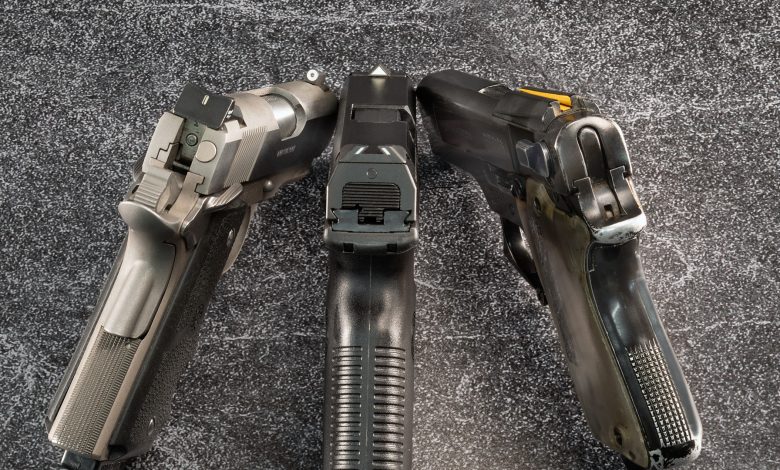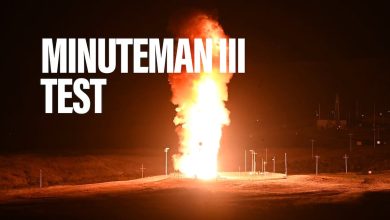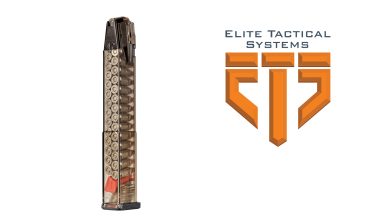Why Iron Sights Still Matter

XS Sights’ Big Dot, the Steyr M-series’ trapezoidal units and the ASP’s Guttersnipe represent alternative iron sights. The Big Dot remains popular.
After rifled barrels and metallic cartridges, probably the most mature and unchanging technology on a carry handgun would be the basic iron sights.
In fact, the iron sights and the centerfire metallic cartridge both achieved their current form at about the same time. If you go back to the 1870s and look at a cavalry trooper’s Colt revolver, it’s going to have a cartridge with a primer located in the center of the case head and the sights will be a trough in the topstrap forming a notch in the center of which the shooter will align the post formed by the silhouette of the front-sight blade.
If you go into your friendly local FFL’s showroom and look at a new-production, fixed-sight, duty-type revolver like a Smith & Wesson Model 10 or a Taurus Model 65, the sight setup remains unchanged: a groove in the back and a blade up front. Further, most revolvers and pistols still feature a variation of this, differing largely in the fact that the sights are separate pieces that are attached to the firearm via dovetails or threaded tenons, or similar means, allowing them to be changed to suit the owner’s preference and visual acuity, as well as the intended role of the handgun.
For instance, you’ll find that people who are using their pistol for defensive purposes, like most readers of this column, prefer a larger front-sight blade, often with some bit of flash on it to enhance its visibility under less-than-optimal conditions such as bright paint, a glowing tritium vial or a fiber-optic light pipe (or some combination of these various add-ons.)
These definitely grab the eye, although they’re not necessarily without their downsides. At a Rangemaster Combative Pistol class with Tom and Lynn Givens some years ago, I was using my Glock G17 with Ameriglo CAP sights, which featured a bright yellow-green square insert surrounding the tritium vial in the fat .14-inch front-sight blade. They were fast to acquire visually, and I’d shot some of my best times in the FAST test with those sights, but when we were shooting the Rangemaster bullseye course of fire, I en- countered a hitch.
By the time you reach 15 yards, the picture of the front-sight blade was pretty much the exact width of the 8-inch black bullseye on an NRA B-8 target. Then at 25 yards? Fuhgged-aboudit. The entirety of the bull was lurking somewhere behind the Ameriglo CAP front, and you had to sort of guess at when it was centered back there.
This is the exact reason that competitive shooters favor thinner front-sight blades: They don’t obscure as much of the target if the target is smaller or distant. For various traditional target sports, a thinner, plain-black sight is used. Some competitors in more active, combat-shooting-derived competitions will use plain-black sights, too, but they tend to have excellent eyesight and the matches are rarely held in the dark, unlike your armed robberies or your muggings, which most often happen in suboptimal lighting conditions.
The rear sight on the competition guns of the bullseye variety tends to have a narrower notch, because there’s not a lot of time pressure in a classic target match. The narrow front sight combined with a narrow rear notch—allowing only the thinnest of “light bars” on either side of the blade—allows greater precision, but it’s S-L-O-W.
For this reason, the rear component of combat-oriented sights tends to be wider relative to the front post, since it’s essentially a window through which the shooter looks to acquire the front sight and target. The bigger the window, the easier it is to see the things you need to see through it. Sometimes the bottom of the notch is U-shaped on the theory that it helps center the dot on the front sight more quickly and reliably.
The Express Big Dot line from XS Sights take this to an extreme, in that the front sight has a rounded top and the rear sight is just a shallow “V,” giving a sight picture like that found on classic “express” rifles used on dangerous African big-game animals. The theory here is that such sights are very fast to get a coarse, “good enough” sight picture on close targets in a hurry. The downside is the difficulty of making precision shots at longer ranges. Some folks love this setup, others don’t. I can’t tell you what the best sights are for your purposes any more than I can tell you what shoes are most comfortable for you. Sights are personal.
I will, however, note that every now and again an oddball “fad” iron sight shape pops up that gets a lot of ink. One of the first I remember was the “Guttersnipe” sight found on the old ASP pistols, chopped-down and tricked-out Smith & Wesson Model 39 semi-automatics. Developed by the colorful (and rather controversial) Paris Theodore, this was a slide that had a long trench machined into it that narrowed toward the front. The sides and floor of this trench were painted in bright yellow in the theory that if you had it correctly aligned, you’d see three bright triangles con–verging on your aiming point. There was no front sight. The fact you don’t see these everywhere now should indicate the rather limited practicality of whatever virtues they offered.
Similarly, every few years you’ll get someone offering a funky variation on classic irons. There were the trapezoidal sights on early Steyr semi-autos, various tries at aperture-style (ghost ring) rear sights and someone even sold an aperture rear sight with a kind of crosshair made of light-channeling fiber-optic pipes.
If you look around the holsters of your local IDPA or USPSA match, to say nothing of a police SWAT team or group of SOCOM door-kickers, you’ll notice a whole bunch of regular, old post-in-front, notch-in-back iron sights (increasingly as backups to red dots) and almost no weird apertures or Guttersnipes or trapezoidal affairs.
This, my friend, is what detectives (and I) call a “clue.”
Read the full article here


![6 New And Upcoming Guns To Watch Out For This 2025 [SHOT SHOW 2025] 6 New And Upcoming Guns To Watch Out For This 2025 [SHOT SHOW 2025]](https://tacticalgunstores.com/wp-content/uploads/2024/11/1730966977_maxresdefault-390x220.jpg)




